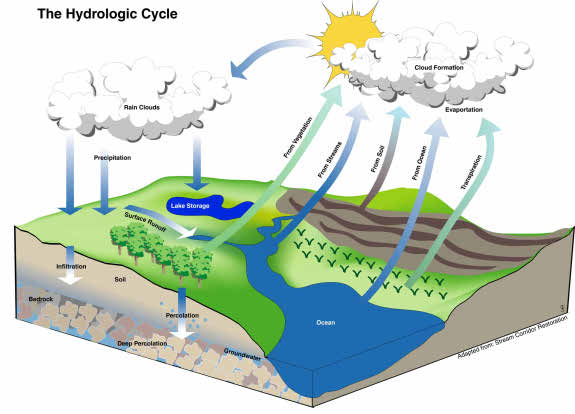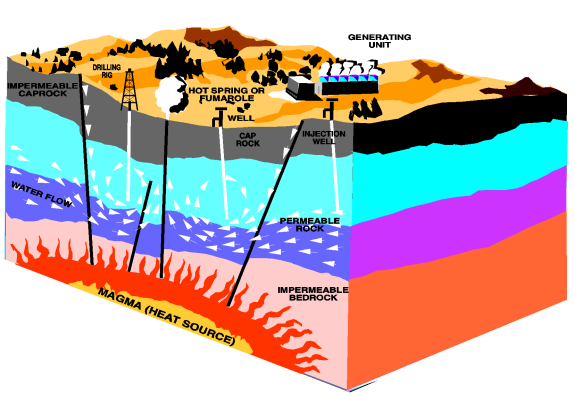
Other secondary sources of energy
Water
Very simply put, everything that sits at a higher altitude in a gravitational field has potential energy. The trick is to convert that potential energy into something we can use, like e.g. kinetic energy that we can use or convert into electrical energy. Kinetic energy is the energy embodied into something that is moving.
Water is a prime candidate for tapping potential and kinetic energy, because of its abundance and the fact that it is usually a liquid under normal conditions. Either we use the flow of water directly (e.g. low head hydro, or wave power), or we use the height of a body of water (the "head") to create a high-velocity stream of water.
The crux of the matter is how do you get a flow of water or a large body of water, since water doesn't flow uphill? This is what is called the water cycle, or hydrologic cycle. Our friend the sun (again) heats water and vaporizes it. The water condenses at cooler (higher) places and runs downhill. So hydropower is indirectly solar power as well. The water (sitting higher-up in the gravity field) is just a storage medium and carrier for the energy.
Wind
Again it is ultimately the sun that drives the wind. Very simply put, sunlight heats earth and water, which heats the air. Hot air rises, causing a flow of air from colder parts. Of course there are lots of other phenomena at play; the aforementioned hydrologic cycle has a large part in it as well.
Geothermal energy
The temperature of the earth increases with depth. This is known as the geothermal gradient. It is mostly caused by the aforementioned nuclear decay happening inside the earth. So ultimately this is also solar energy.
Now a peculiar property of heat is that the higher the temperature, the more efficiently you can convert heat into mechanical energy, which is the most used form to provide transportation and is the most-used precursor to electric energy. In most places the gradient is between 25 to 30 degrees Kelvin (or Celcius) per kilometer depth, which means you've got to drill a pretty deep hole to get at the really hot stuff, unless you're near a geologically active area. Of course you don't need a very high temperature for heating your house. If you've got enough water of say 27 degrees Celcius (80 F) you could very well heat your house with it. Of course, drilling a hole over a kilometer deep is quite expensive.

This work
is licensed under a Creative Commons
Attribution 3.0 Unported License.
| This post is part of our Energy Primer lunchtime series.
Read all of the entries: |
Want more in-depth information? Browse through our books.
Or explore more posts by date or by subject.
About us: Anna Hess and Mark Hamilton spent over a decade living self-sufficiently in the mountains of Virginia before moving north to start over from scratch in the foothills of Ohio. They've experimented with permaculture, no-till gardening, trailersteading, home-based microbusinesses and much more, writing about their adventures in both blogs and books.
Want to be notified when new comments are posted on this page? Click on the RSS button after you add a comment to subscribe to the comment feed, or simply check the box beside "email replies to me" while writing your comment.
- Remove comment
- Remove comment
- Remove comment
 (Yeah, yeah, maybe we'll do something like that once we finally finish the hundred foot water line that has taken us over a year...
(Yeah, yeah, maybe we'll do something like that once we finally finish the hundred foot water line that has taken us over a year...  )
)
- Remove comment


